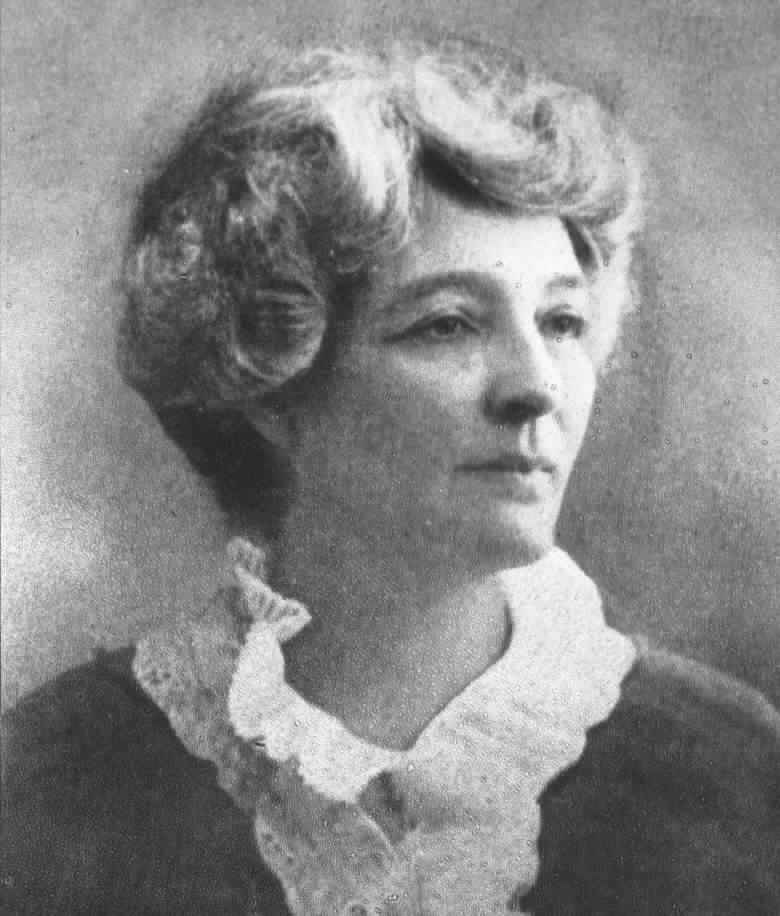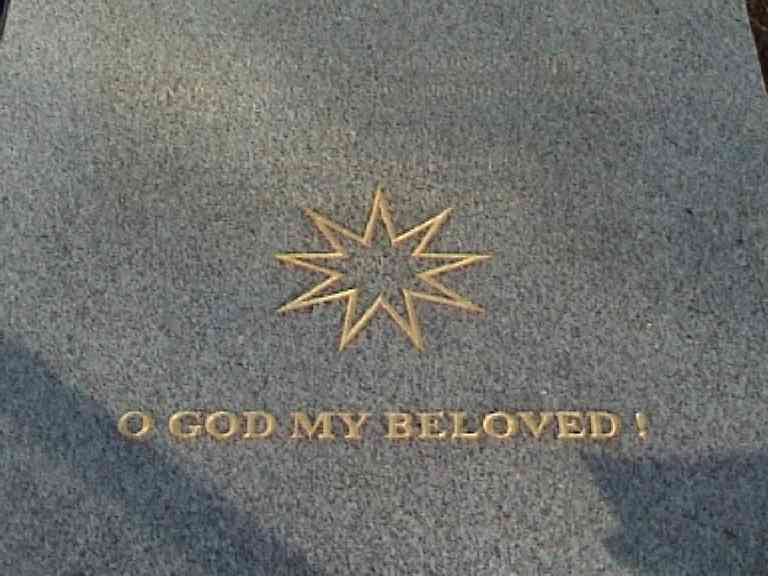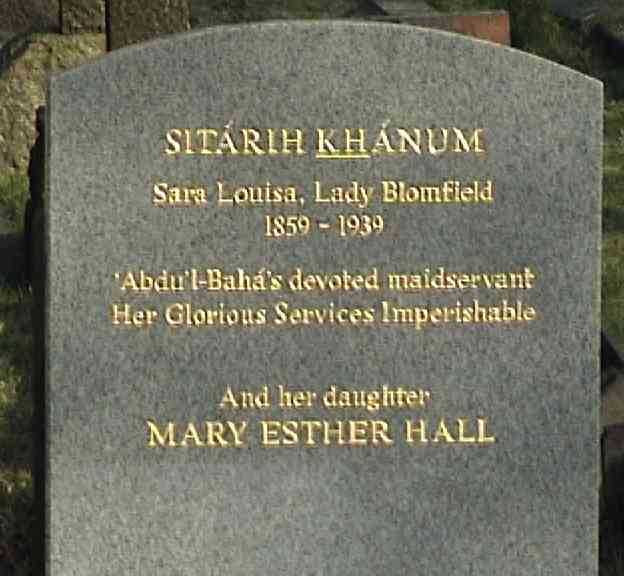A MEMORIAL TO LADY BLOMFIELD
A very special goal was achieved for the Bahá’ís of the United Kingdom in early 2003: after several years of painstaking negotiation and planning, a befitting memorial was erected at the grave in north London of Sara Louisa, Lady Blomfield, one of the most distinguished of the Faith's early western believers .She was the first person of Irish birth in Britain to become a Bahá’í
Lady Blomfield was one of the most remarkable women of her age. Born in County Tipperary, Ireland, to a Catholic father and Protestant mother whose marriage broke down owing to religious tensions, she achieved considerable renown as a London society hostess, the second wife of the distinguished architect Sir Arthur Blomfield. While many women of her generation and position occupied themselves primarily with polite society, Lady Blomfield spent her life in social and humanitarian activity. She was a fearless supporter of the suffragettes and a protector of the rights of women, children, prisoners and animals, a defender of the oppressed and an ardent promoter of peace and inter-religious understanding. She is perhaps best-known now for her involvement in the establishment of the Save the Children Fund in the aftermath of World War I and as an active early promoter and defender of the Faith.
Lady Blomfield's acceptance of the Bahá’í teachings in 1907 marked the turning point in a lifelong quest for spiritual truth. Through her identification with the Faith came an increased desire to see justice and equality established in the world, a concern expressed in her selfless involvement in all manner of philanthropic causes as well as in direct service to the needy or oppressed, including her intimate involvement with the League of Nations and the welfare of the world¹s children.
 Lady Blomfield's services to the Faith were
extensive. She spent invaluable time with 'Abdu'l-Bahá in Paris and her
copious notes of his many talks and conversations formed the substance of the
book, Paris Talks. She established a Bahá’í centre in Geneva
and promoted the Bahá’í teachings amongst the establishers
of the League of Nations. She actively called upon her friends in the British
parliament to defend the persecuted Bahá’ís of Persia. She
acted in loco parentis for Shoghi Effendi when he was studying in Oxford and
accompanied him back to Haifa on the passing of
'Abdu¹l-Bahá. She was one of the distinguished western
believers invited to consult with Shoghi Effendi about the future of the Cause
following his discovery that he was now the Guardian of the
Bahá’í Faith. When Queen Marie of Romania was expected to
visit Haifa, Shoghi Effendi called on Lady Blomfield to join him and the
Greatest Holy Leaf in the Holy Land to welcome her. The Queen¹s
itinerary was diverted by her interfering advisers, but Lady Blomfield spent
the time interviewing members of the Holy Family about their memories - stories
which formed the basis of her timeless book, The Chosen Highway. The book also
provides an inspiring account of the period when she gave up her home to
'Abdu¹l-Bahá on his historic visits to Britain in 1911 and
1913. It was He who gave her the name Sitarih, meaning star.
Lady Blomfield's services to the Faith were
extensive. She spent invaluable time with 'Abdu'l-Bahá in Paris and her
copious notes of his many talks and conversations formed the substance of the
book, Paris Talks. She established a Bahá’í centre in Geneva
and promoted the Bahá’í teachings amongst the establishers
of the League of Nations. She actively called upon her friends in the British
parliament to defend the persecuted Bahá’ís of Persia. She
acted in loco parentis for Shoghi Effendi when he was studying in Oxford and
accompanied him back to Haifa on the passing of
'Abdu¹l-Bahá. She was one of the distinguished western
believers invited to consult with Shoghi Effendi about the future of the Cause
following his discovery that he was now the Guardian of the
Bahá’í Faith. When Queen Marie of Romania was expected to
visit Haifa, Shoghi Effendi called on Lady Blomfield to join him and the
Greatest Holy Leaf in the Holy Land to welcome her. The Queen¹s
itinerary was diverted by her interfering advisers, but Lady Blomfield spent
the time interviewing members of the Holy Family about their memories - stories
which formed the basis of her timeless book, The Chosen Highway. The book also
provides an inspiring account of the period when she gave up her home to
'Abdu¹l-Bahá on his historic visits to Britain in 1911 and
1913. It was He who gave her the name Sitarih, meaning star.
In addition to all these activities, Lady Blomfield served many years on the London Spiritual Assembly and the National Spiritual Assembly of the British Isles. She spoke at the first Summer Schools in this country, hosted Firesides, Holy Days and 'at home' meetings, supported artistic activities in the community including a Bahá’í Theatre Group in London, and maintained correspondence with Bahá’ís all over the world.
Lady Blomfield¹s passing on the last day of 1939 was widely mourned. Reflecting on her mother's final moments, her daughter Mary Basil Hall wrote that 'in the overwhelming sorrow of parting from a wonderful personality and a deeply loved mother, it is hard to rejoice in the gladness that is hers....From the earliest days her valiant spirit meeting sadness and difficulties with radiant acquiescence and invincible faith. It was as if she knew what rare privilege awaited her, since she it was who welcomed 'Abdu'l-Bahá to her her home when he came to England.
Lady Blomfield was buried at the Hampstead Municipal Cemetery. Later, in 1950, the mortal remains of her daughter, Mary - herself a devoted Bahá’í and member of the National Spiritual Assembly for five years - were also interred in the same grave. Mary was given the name 'Parvine' by 'Abdul-Bahá. It was partly thanks to a generous contribution to the National Fund from her will that the National Spiritual Assembly was able to purchase 27 Rutland Gate, hence the Drawing Room being known originally as the Parvine Room.
Visiting the grave
Visiting the final resting places of our spiritual forebears can be a great source of grace and bounty. In a tablet addressed to Lady Blomfield's co-worker Ethel Rosenberg, 'Abdu'l-Bahá comments: '...as to the other resting places of martyrs and holy souls, it is pleasing and acceptable in the sight of God if a person desires to draw nigh unto Him by visiting them.' Elsewhere, the Master stated, 'I long to visit the graves of the friends of God, could this be possible. These are the servants of the Blessed Beauty; in His path they were afflicted; they met with toil and sorrow; they sustained injuries and suffered harm. Upon them be the glory of God, the All-Glorious. Upon them be salutation and praise, Upon them be God's tender mercy and forgiveness.'
Hampstead Municipal Cemetery is to be found just off Fortune Green Road as it joins Finchley Road. The nearst Underground station is West Hampstead on the Jubilee Line. Lady Blomfield's grave is to be found by entering through the main gates, turning right at the first avenue and then immediately left onto a gravel path running parallel to the main drive. After about 100 yards there is a black marble headstone with the name Helena Narkowicz on it. Enter the section at that point and Lady Blomfield's grave is in the sixth line of graves and one grave to the right. The National Spiritual Assembly wishes to record its deep appreciation to Mr David Lewis, Mr Ron Batchelor and Michelle Wilburn for their dedication to and successful completion of this project.
 |
 |
Slightly edited from an article by Rob Weinberg first published in Bahá’í Journal UK and on the UK Bahá’í Heritage website
